 |
Spitfire
V BL688 - Walmersley
29th May 1945 |
 |
Spitfire
V BL688 - Walmersley
29th May 1945 |
Updated on 24.03.2008
| Type | Unit | Base | Duty | Crew | Passengers |
| Spitfire Vb | 58 O.T.U. | Hawarden | Sector Reconnaissance flight | 1 | - |
On 29.05.1945 Spitfire Mk. Vb, Serial No. BL688 was being flown by 20 year old Sgt. Zygmunt Bauerek on a Sector Reconnaissance flight, as he was a new pupil at No. 58 O.T.U. based at Hawarden. The flight lasted 45 minutes and the aircraft carried a normal fuel load only, i.e. no ammunition. The pilot was killed instantly when the aircraft struck high ground at 700 feet in "very bad" visibility. His body was reported as recovered during a five-day operation by No. 75 M.U. (Maintenance Unit), though local newspaper reports noted that those first on the scene had, in fact, pulled the pilot clear and extinguished his burning clothing with wet soil. Nevertheless, this is one of the few such recoveries to be documented in considerable detail in the Operational record book for the unit, and it describes the apparently arduous recovery of the engine, which was said to be embedded over 12 feet deep in clay and could only be reached by spade digging. Weather conditions were described as appalling and the lifting cables on the two Coles cranes they were using broke no less than five times! Sgt. Zygmunt Bauerek is buried at Newark Cemetery, Section N, Grave No. 329.
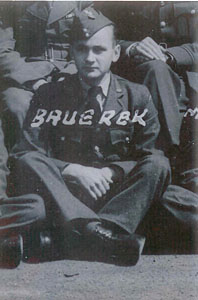 |
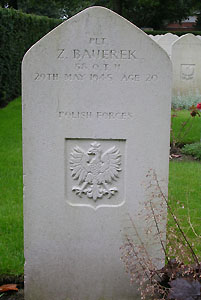 |
| Sgt. Zygmunt Bauerek. |
His grave at Newark. |
| Name | Position | Status |
| Sgt. Z. Bauerek | Pilot | K. |
Spitfire Mk. Vb, Serial No. BL688 had a remarkably long and varied service career: It was delivered to No. 9 M.U. on 25.01.1942 and allocated to No. 132 squadron on 13.03 1942 , but did not last long as it was listed as Damaged "CAT ? FB" [Flying Battle] on the 16th March. Following repair it was allocated to 610 Squadron on 14th October and then on to Scottish Aviation at Prestwick on 18th December. It was listed as being "repaired in works" on 31st December and completed and awaiting collection by 18th January 1943. On 26.01.1943 it was on charge of No. 46 M.U. and was allocated to United States Army Air Corps (U.S.A.A.C.) No. 335 Squadron (formerly RAF No. 121 Eagle Squadron) based at Debden. Again it only remained with this unit a short time, probably as 335 Squadron was converting to P-47s and on 23rd march it was allocated to No. 501 Squadron. On 12.04.1943 it was again damaged, this time Category A (able to be repaired on site), though on 31st May it went to 3501 S.U. (servicing Unit) and returned to 501 squadron on 1st June. On 14.07.1943 BL688 was sent to CRD (Contractors Repair Depot) Rolls Royce and on 9th October it is listed as being R.I.W. (repaired in works), then to No. 9 M.U. on 8th November. Finally on 3rd December it was allocated to No. 316 squadron until 27.04.1944 when it was noted as being on charge of RAF Woodvale - probably left there by 316 Squadron as they converted to Mustang IIIs at around this time. On 01.05.1944 it was allocated to No. 63 Squadron, lasting until 4th November when it was damaged yet again, this time category A/C (repair beyond the capacity of the unit) and sent to AST (Air Service Training Ltd) at Exeter, being R.I.W. on the 16th and listed as completed and awaiting collection by 27.02.1945. Then to No. 6 M.U. on 09.03.1945 and allocated to No. 58 O.T.U. on 16.03.1945, transferring to No. 41 O.T.U. on 22nd March, but back to No. 58 O.T.U. (no date given) until its loss on 29.05.1945.
Due to the publication of the 75 M.U. ORB extract on BL688 in an early edition of Flypast magazine, this site has attracted quite a bit of attention over the years, in spite of this report indicating that the recovery had eventually been completely successful! We believe that two groups had investigated the site in the past and although one apparently found nothing, the other carried out a limited excavation and parts attributed to BL688 were at one time on display at the Fort Perch Rock museum. Despite being led to believe that there was nothing left at the site, we now and make a point of investigating many such unpromising / previously excavated sites & the results speak for themselves! Our initial research was limited to searching for documentation on BL688, but as with most North West Spitfire MkV incidents, there was no Form 1180 available. However, we were fortunate to discover that the Form 78 still exists as well as more importantly an AIB report in the PRO - it was the latter document that aroused my interest as there were obvious discrepancies with the M.U.'s report, especially as it stated that the recovered engine was apparently incomplete and of no use to the AIB!
The landowner has been on the farm since 1962 and believed he knew the exact location of the impact - indeed several visitors to the farm have enquired about it over the years and been shown the "crater" & none questioned it - including the group who found nothing after searching the whole field. He stated categorically that NO excavation has ever taken place - as for the origin of the parts (now gone) that I had seen at the Fort Perch Rock museum, all I can say is that they were in poor condition, probably having come from close to the surface and were almost certainly detector finds. Despite the farmer's sceptiscm that anything would be found, permission was granted for a metal detector search of the "Spitfire field" in march 2006 and we were taken to the site - it was immediately obvious something was wrong, the "crater" was far to big and obviously very old (centuries in fact! - in our opinion it was more likely a small stone quarry where material was removed for the building of a nearby farmhouse over 100 years ago). Nothing aircraft related was found in or near it, so we politely asked to extend our search to the adjacent fields and the puzzled farmer left us to it!
|
|
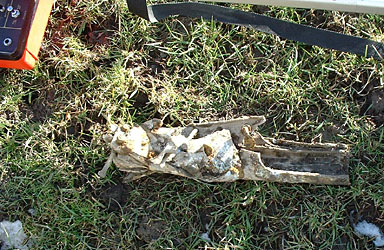 |
|
Pinpointing the crash site - Note slight depression |
Section of Spitfire main wing spar. |
Two hours grid searching later we had discounted the first field and having surveyed the surrounding area, I visually spotted a likely shallow and wet depression in the next field. As we went through the gate and started to walk towards the spot, non ferrous signals from the detectors started almost immediately until they were over lapping and it was time to switch to more sophisticated deep seeking machines. The largest part recovered from just a few inches down was approx 18" of main wing spar with the characteristic layered Spitfire construction & 300 prefix stamps + further pieces were visible leading down into the ground below it - A detector sweep around the depression netted one bucket full of small scraps. A strong, but over a small area, magnetometer reading indicated some remaining wreckage lay below the surface and a further substantial ferrous contact was recorded some 6 feet from the main crater and parts identified as originating from a 20mm Hispano cannon were found here just below the surface. The farmer was suitably impressed, as he recalled his own fruitless searches for parts of the plane as a young boy and permission for a full excavation was given to take place later in the year.
|
|
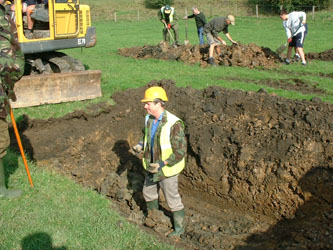 |
| The excavation of BL688 gets underway. |
The first fragments of BL688 begin to emerge |
We returned in September 2006 with a tracked excavator on a beautiful day for the excavation of BL688, hoping that the recovery team in 1945 had indeed left parts of the aircraft in situ. Initial removal of the topsoil looked promising - clearly no one had dug here in the last 60 years, as just below the topsoil, the ash and gravel used to level the crater was clearly undisturbed. The first find was a remarkably intact wooden propeller blade, obviously thrown back in with the back fill after the recovery. Odd small parts were recovered from the infill, including two instrument faces, crumpled pieces of airframe and the smaller reduction gear. At approx five feet down a small cache of parts was uncovered, including a remarkably undamaged radio hatch and a superbly preserved Magneto - the later object proved to be the source of the main magnetometer reading, as this machine is very sensitive to magnetised metal. Interestingly the magneto bore a Packard makers plate, yet the Merlin was clearly Rolls Royce from the other parts found - could this be a result of the aircraft having been on the strength of the U.S.A.A.C. 335th Fighter Squadron at Debden in 1943?
|
|
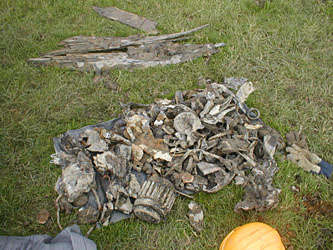 |
| A cache of parts is uncovered at approx. 5 feet below the surface. |
Recovered artefacts; top is a piece of shoring
timber and below is the wood propeller blade. |
At around seven feet the disturbed soil gave way to natural undisturbed boulder clay and double checking using our detecting equipment indicated that no further metal debris lay below this depth - clearly the "over 12 feet" depth to which the recovery crew stated they had dug was somewhat exaggerated! We widened the hole approx two feet as clearly disturbed soil was visible to one side of our excavation, but found only tiny fragments and eventually encountered the remains of wooden shoring boards from the 1945 recovery.
 |
 |
|
The Hispano 20mm cannon uncovered. |
The armour plate that protected the 20mm ammunition |
Having filled in the main crater excavation and replaced the top soil, we then turned our attention to the second magnetometer contact some six feet way. Having recovered a stainless steel compressed air fitting and what turned out to be an ammunition drum locking lever from just under the surface on our initial site investigation, we were hopeful that this was the entry point of a 20mm Hispano cannon. The digger soon cleared the topsoil and a dark stain indicated something had indeed penetrated deeply at this point. The next bucket full brought up a few airframe fragments and revealed a pocket of debris with a straight edge of a larger piece of wreckage - this was of course dug out by hand and proved to be the armour plate section from behind the 20mm ammunition drum. This piece was large enough to account for the magnetometer readings on its own, so the digger was moved clear and the area re-surveyed, but a strong signal remained. Another bucket full revealed the back end of the breech of the predicted 20mm cannon, much to the relief of all present. This was then carefully uncovered and its position and angle of impact noted, until it could be safely lifted clear, revealing a nice straight barrel and satisfactory conclusion to the dig.
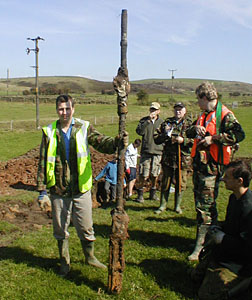 |
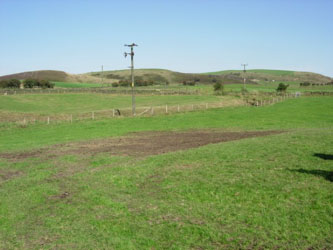 |
|
A satisfactory conclusion to the dig! |
The reinstated crash site following our excavation. |
Alan Clark, Gareth Brown, Roland Edwards, Mark Gaskell, Dick Baker, John Tyrer, Edus Ltd. Polish Institute and Sikorski Museum.
This page & all articles on this site Copyright © Nick Wotherspoon 2008